White Post Animal Farm of Melville
250 OLD COUNTRY ROAD MELVILLE NY 11747
Festival tickets include the Animal Farm.
Use code FFSUMMERSALE at checkout
to receive $10 off each Fall Festival Ticket
DISCOUNT TICKETS REDEEMABLE ONLY ON SEP 23, 24, 30 & OCT 1
*If redeemed after October 1 Customer must pay
the difference for the full price ticket
Following the CDC guidelines and Governor Cuomo’s mandate: Any patrons whom are vaccinated do not need to wear a mask, as per the CDC children 2-11 who cannot be vaccinated do not need to wear a mask unless they are in an indoor environment.
If you are not vaccinated please continue to wear a mask. Children under 2 do not require a mask.
Meet Our Animals
Reticulated Giraffe
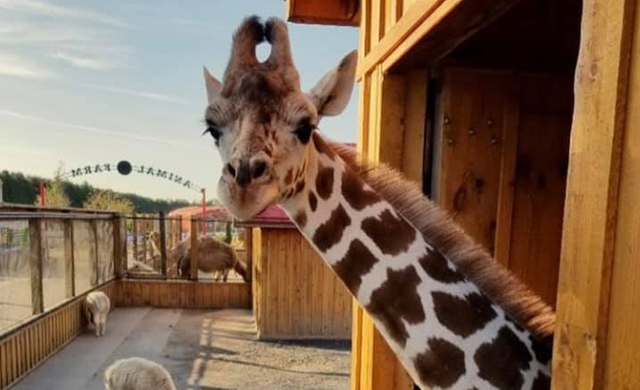
Read More
Origin: Horn of Africa The reticulated giraffe, also known as the Somali giraffe, is a subspecies of giraffe native to the Horn of Africa. It lives in Somalia, southern Ethiopia, and northern Kenya. There are approximately 8,500 individuals living in the wild.
Species: Giraffa camelopardalis reticulata
Reticulated giraffes can interbreed with other giraffe species in captivity or if they come into contact with populations of other species in the wild.
Its coat consists of large, polygonal, liver-colored spots outlined by a network of bright-white lines. The blocks may sometimes appear deep red and may also cover the legs.
Giraffes are the tallest mammals in the world.
Grant's Zebra
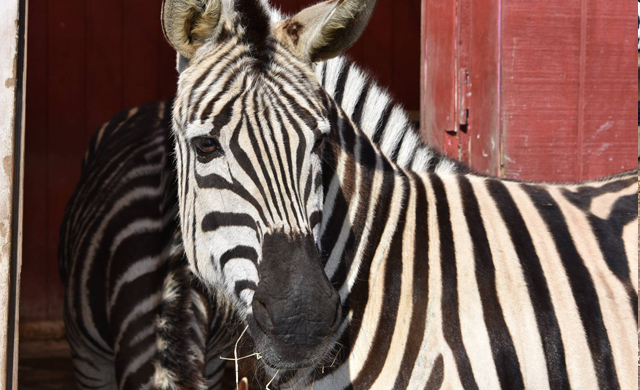
Origin: Eastern & Southern Africa
Scientific Name: Equus quagga boehmi
Grant’s Zebra is the smallest of the six subspecies of the plains zebra. They weigh between 485 and 700 pounds and have a shoulder height of 4 to 4 1/2 feet.
Zebras have excellent eyesight and hearing. It is believed they can see in color.
Zebras take dust or mud baths to get clean. They shake the dirt off to get rid of loose hair and flaky skin. What’s left protects them from sun, wind, and insects.
Zebras have their own “smile,” a bare-teethed grimace that serves as a greeting and helps prevent aggression.
Zebras are black with white stripes, not white with black stripes. They have black skin under their hair.
Bactrian Camel
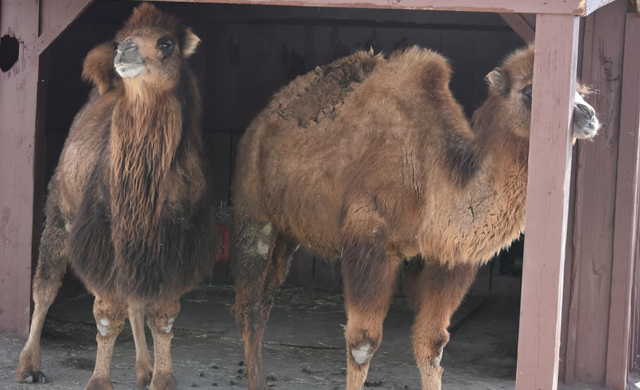
Origin: Eastern Asia
Species: Camelus bactrianus
The IUCN’s Red List of Threatened Animals lists wild Bactrian camels as critically endangered. There are only 1400 wild Bactrians left in the world. Hunting has continued to have a major impact on wild Bactrian to the present day.
The Bactrian camel is one of the world’s rarest animals.
The Bactrian camel has two humps on its back, in contrast to the dromedary camel which has one.
Bactrian camels have two coats, the warm inner coat of down and a rough outer coat which is long and hairy. Bactrian camels shed both their coats in clumps. Up to 15 pounds annually.
They are capable of drinking over 30 gallons of water at one time.
Dromedary Camel
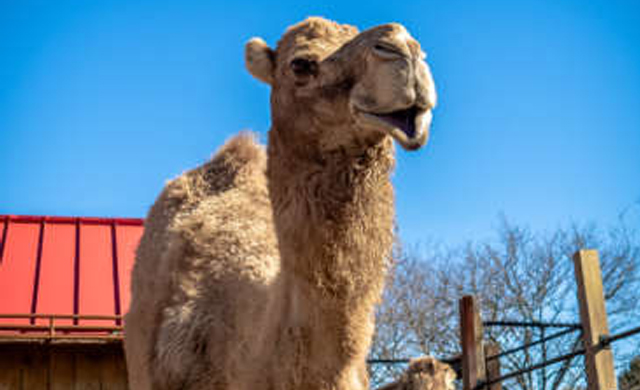
Origin: Asia, Middle East & Australia
Scientific Name: Camelus dromedaries
The Dromedary Camel is also called the Arabian Camel.
It is the tallest of the species of camels. Male camels can be as much as 6.6 ft at the shoulder.
The Dromedary is known for having one hump, in contrast to the Bactrian Camel which has two. Like all camels, the hump is composed of fat bound by fibrous tissue.
Dromedaries were domesticated as far back as 4000 years ago for the transport of humans and goods. The wild population of dromedaries disappeared completely 2000 years ago.
They have been known to travel as much as 100 miles without water.
Nilgai Antelope
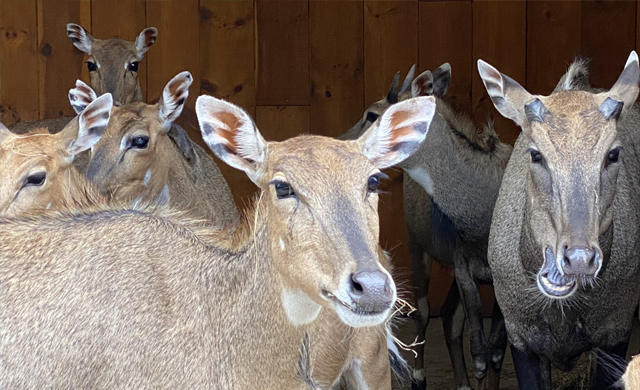
Origin: Northern Asia, Pakistan
Scientific Name: Boselaphus tragocamelus
The Nilgai is the largest antelope in Asia.
The males are much bigger than females.
Males are bluish-grey. Females and juveniles are orange to tawny.
They can now also be found in Texas, introduced to the area on a ranch in the 1920s.
Nilgai prefers to live in small groups.
They are herbivores (plant-eaters) & diurnal (active during the day).
Aoudad
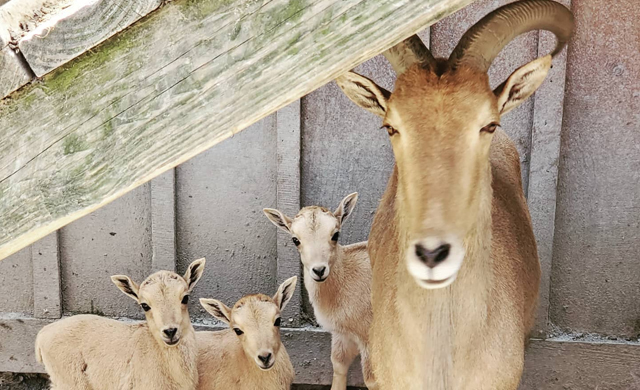
Origin: Northern Africa
Scientific Name: Ammotragus lervia
Aoudads are also called Barbary Sheep
Aoudad horns can exceed 40 inches in length and are made of keratin (just like your fingernails!)
They are skilled at climbing steep inclines.
They are crepuscular (active in morning and evening, sleep in the heat of the day).
A group of Aoudads is called Anger.
Muntjac
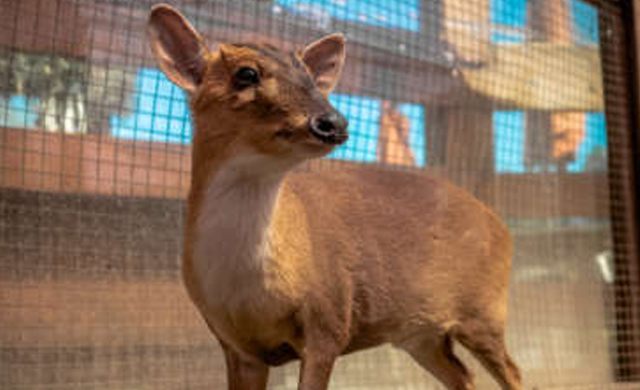
Origin: South East Asia
Scientific Name: Muntiacus Reevesi
Reeve’s Muntjacs are also known as barking deer.
They are the oldest deer known to man.
Male muntjacs have “tusks” which can be useful when in a fight for territory.
They communicate with vocalizations and chemical signals.
A baby Muntjac is called a fawn, kid or calf. A group of muntjacs is called a herd, mob or gang.
Kunekune
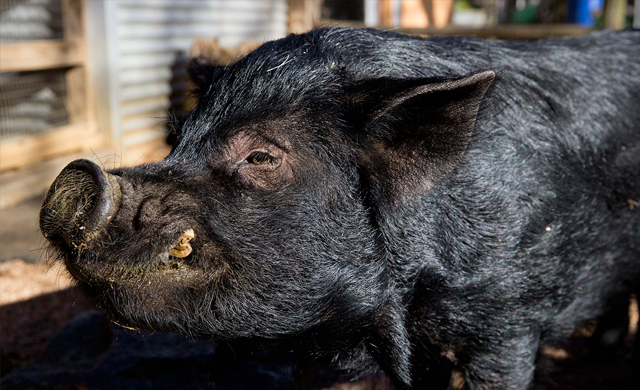
Origin: New Zeland
Scientific Name: Sus scrofa domesticus
Kunekune are hairy with a rotund body.
Their color ranges from black and white, to ginger, cream, gold-tip, black, brown and tricolored.
Kunekunes were once critically endangered, but careful conservation efforts brought them back from the brink of extinction.
Kunekune are the smallest breed of pigs. They can grow up to be about 4 feet and between 130 – 220 lbs.
They live for 8-10 years.
A small breed of domestic pig from New Zealand
Patagonian Cavy
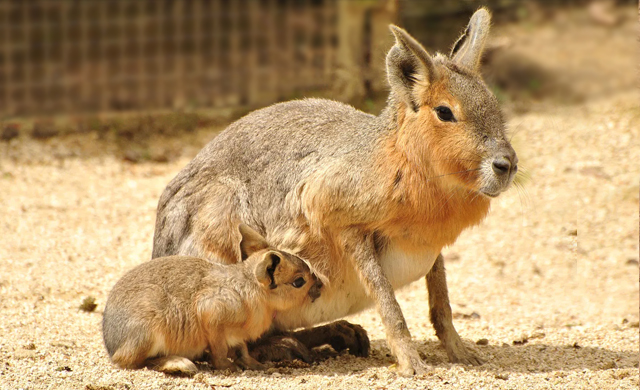
Origin: Argentina
Scientific Name: Dolichotis patagonum
The Patagonian cavy is also known as the Patagonian mara or the Patagonian hare. They are often said to look like a cross between a rabbit and a deer.
Their feet are distinctive in shape as well, with a rounded and compact shape that makes them appear to be hoof-like at first glance.
They most commonly travel in pairs and often mate for life.
The male Patagonian cavy is particularly protective of his partner and exhibits the unique behavior of marking her and the area around her with his urine.
Zebu
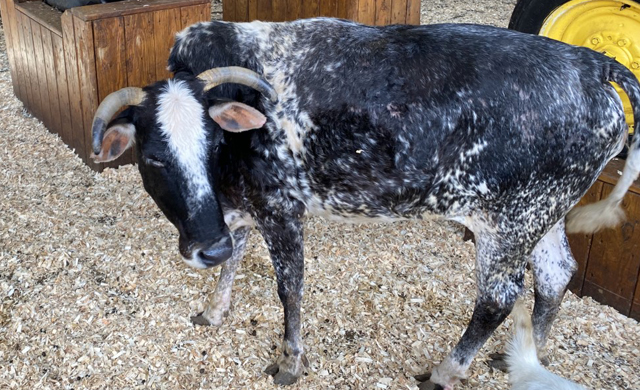
Origin: South Asia
Scientific Name: Bos primigenius indicus or Bos indicus or Bos taurus indicus
The Zebu sometimes known as indicine cattle or humped cattle is a species or subspecies of domestic cattle originating in South Asia.
Zebu are characterized by a fatty hump on their shoulders, a large dewlap, and sometimes drooping ears.
They are well adapted to withstanding high temperatures and are farmed throughout the tropical countries, both as pure zebu and as hybrids with taurine cattle, the other main type of domestic cattle.
Zebu are used as draught and riding animals, dairy cattle, and beef cattle, as well as for byproducts such as hides and dung for fuel and manure.
Brahman Cattle
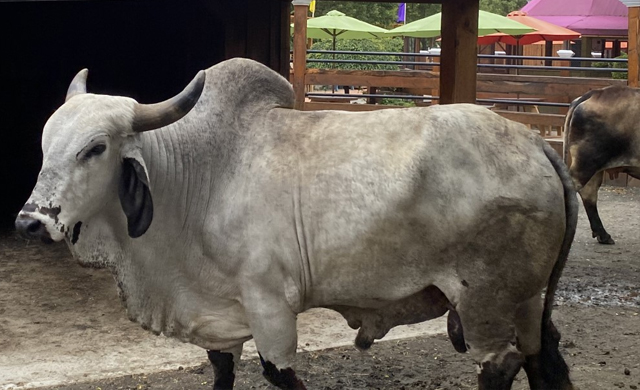
Origin: United States
Species: Bos taurus indicus
Originated from the cattle that are considered the “sacred cattle of India”.
They adapt well to any climate, especially areas with high temperatures and humidity
Their thick skin makes them resistant to insects.
Bulls are darker in color.
Bulls can weigh over 1950 pounds. The cow can weigh over 1300 pounds.
Miniature Hereford Cattle
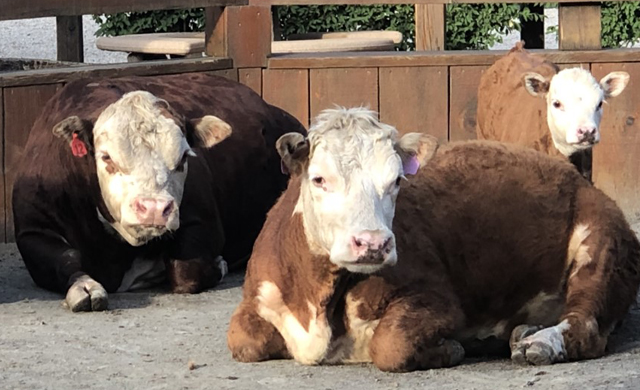
Origin: England
Scientific Name: Bos taurus
Miniature Hereford cattle are descendants of purebred Hereford cattle from Herefordshire, England. They are simply not as tall as the standard Hereford.
In the late 1960s, a ranch in Texas selectively bred Hereford bloodlines to create the miniature cattle breed of today.
The mothering instincts of the Hereford cow are excellent, and they provide plenty of protection for calves in areas where predators may be lurking.
Calves sired by Hereford bulls almost always have a distinctive white head.
Umbrella Cockatoo
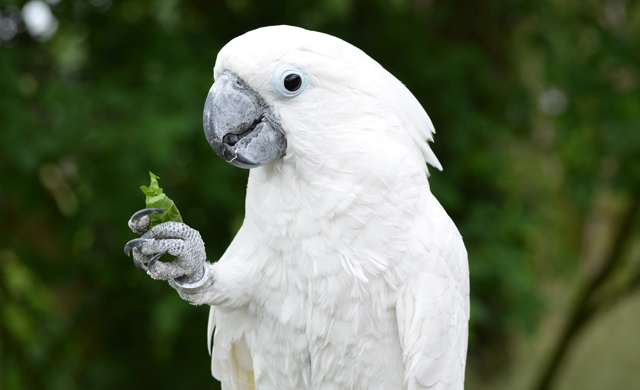
Origin: Indonesia
Species: Cacatua alba
The IUCN lists the umbrella cockatoo as ENDANGERED. Its numbers have declined due to capture and habitat loss.
When surprised, it extends a large and striking head crest, which has an “umbrella” shape.
The Cockatoo’s feet are zygodactyl. Two toes face forward and two face back.
They have very strong beaks which can be easily used to crack walnuts.
Umbrella cockatoos can learn a large number of words and are able to construct simple sentences with the words they learn.
Lovebird
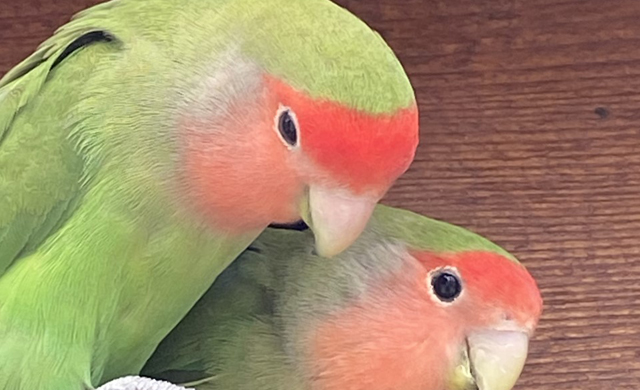
Origin: Southwestern Africa
Scientific Name: Agapornis roseicollis
The lovebird’s name comes from their strong, monogamous pair bonding and the long periods which paired birds spend sitting together.
Lovebirds are loud and constant chirpers. They are renowned for their sleep position in which they sit side-by-side and turn their faces in towards each other.
The females tear raw materials into long strips, “twisty-tie” them onto their backs, and fly substantial distances back to make a nest.
A typical lovebird clutch will have 4 to 6 eggs.
Lovebirds typically live from 10 to 15 years but may reach up to 20 years domestically.
Rainbow Lorikeet
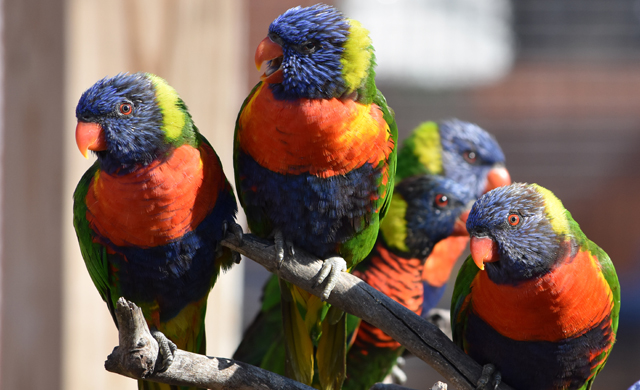
Origin: Australia, Eastern Indonesia, Papua New Guinea, New Caledonia, Solomon Islands, and Vanuatu
Scientific Name: Trichoglossus moluccanus
Rainbow lorikeets have very bright coloring which includes an orange beak, a blue head with green on the back and a chest that is a reddy-orange with black bars. It has green wings and tail.
Baby lorikeets have a black beak instead of an orange one which changes color as they grow older.
Lorikeets are characterized by their specialized brush-tipped tongues for feeding on various nectars.
Lorikeets are generally monogamous, in most cases mating with one bird for life.
Budgerigar “Budgies”
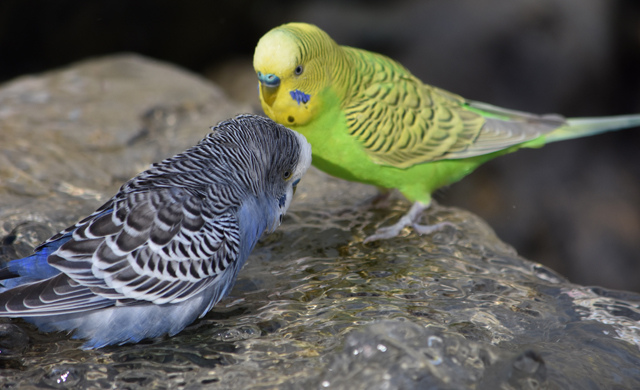
Origin: Australia
Scientific Name: Melopsittacus undulates
Budgies are the most popular type of pet bird. In fact, 45% of pet birds in the United States are budgies. Worldwide it is the most popular pet after the dog or cat.
The cere is the area with the nostrils above the beak. Male budgies have blue ceres, and females have white, pink or brown ceres.
While budgies have been bred to be specific colors, the only natural color is green.
Puck, a male budgerigar owned by American Camille Jordan, holds the world record for the largest vocabulary of any bird, at 1,728 words.
Cockatiel
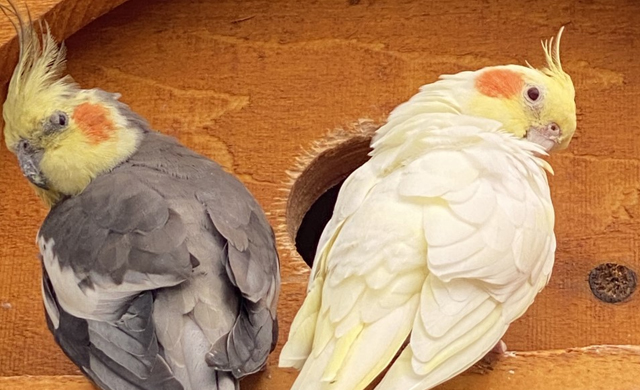
Origin: Australia
Scientific Name: Nymphicus hollandicus
The cockatiel is the smallest member of the cockatoo family.
The face of the male cockatiel is yellow or white, while the face of the female is primarily grey or light grey. Both males and females have a round orange area on their ears, often referred to as “cheddar cheeks.”
Cockatiels can be taught to sing specific melodies and speak many words and phrases.
The cockatiel’s distinctive erectile crest expresses the animal’s emotional state. The crest is dramatically vertical when the cockatiel is excited and flattened close to the head when the animal is angry.
Their long tail feathers roughly make up half of their total length.
Guinea Turaco
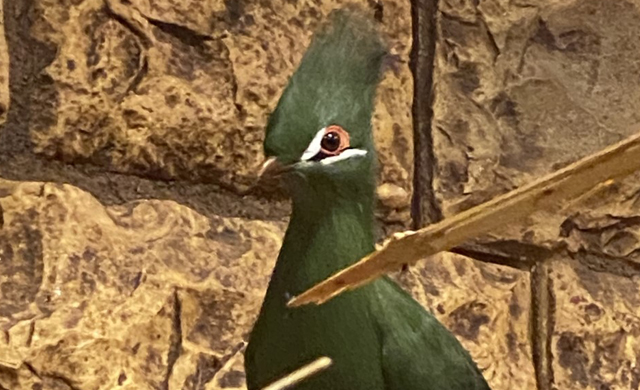
Origin: Western & Central Africa
Scientific Name: Tauraco persa
Turacos are the only birds to possess true red and green colors. When you look at most birds, the color you are seeing is a reflection produced by the feather structure. In fact, if you stirred a glass of water with a red turaco feather, the water would turn pink!
These birds have mobile outer toes, which they are able to rotate forward or backward.
On their heads is a beautiful crest, which stands about 5 cm (2 in.) tall when they are excited.
They are monogamous inbreeding. During courtship, the male will feed the female. Together, they build their nest; mother and father take turns sitting on the eggs.
Violet Turaco
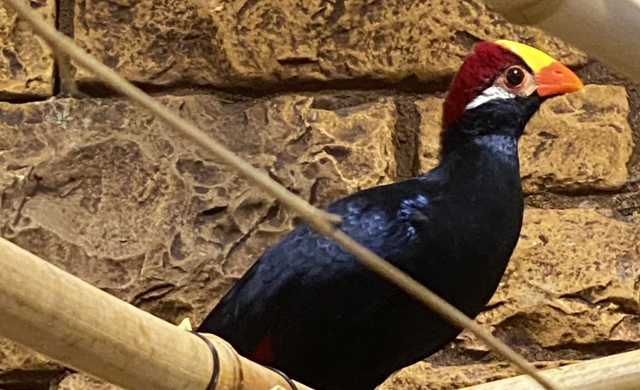
Origin: Central Africa, from Senegal to the Central African Republic
Scientific Name: Musophaga violacea
Averaging 19 inches in length, violet turacos are named for their rich purple feathers.
They build flimsy nests from twigs and branches, with females laying two eggs on average.
They have semi zygodactylous toes, which means the outer toe can move forward or backward depending on the situation
Turacos produce their vivid colors with the bright-red pigment turacin.
They’re unique in their ability to store this pigment.
Violet turaco has a loud cooroo-cooroo call.
Chicken

Origin: Asia
Scientific Name: Gallus gallus domesticus
Chickens aren’t completely flightless—they can get airborne enough to make it over a fence or into a tree.
With 25 billion chickens in the world, there are more of them than any other bird species.
A mother hen turns her eggs about 50 times per day and can lay more than 300 eggs per year. The record number for eggs laid by a chicken in one year is 371.
Mother hens talk to their chicks while they’re still in the eggs, and the chicks can chirp back while in the shell.
Chickens have prehistoric roots and are the closest living relative of the Tyrannosaurus Rex.
Ostrich
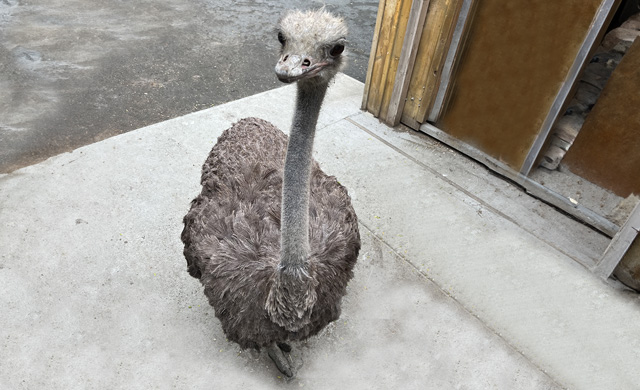
Origin: Africa
Scientific Name: Struthio camelus
Ostriches cannot fly.
The common ostrich is the largest and heaviest living bird. Males stand 6’11” to 9′ tall and weigh 220–290 lbs, whereas females are about 5’9″ in to 6’3″ tall and weigh 200–260 lbs.
They lay the largest eggs of any living land animal averaging almost 6″ in length and 5″ in width.
Ostriches have the ability to run at 43.5 mph they are the fastest birds on land.
Dwarf Rabbit
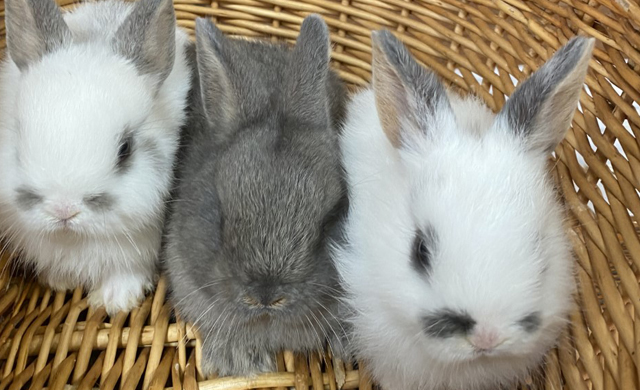
Origin: Europe
Scientific Name: Oryctolagus cuniculus
Dwarf rabbits are the smallest species of domestic rabbits.
Dwarf rabbits vary in size from about one and a half pounds to three and a half pounds.
Dwarf rabbits have very small stomachs and that can sometimes make them very sensitive to some types of food.
Dwarf rabbits are a popular pet in the United States. They can be litter trained and learn simple commands.
Goat
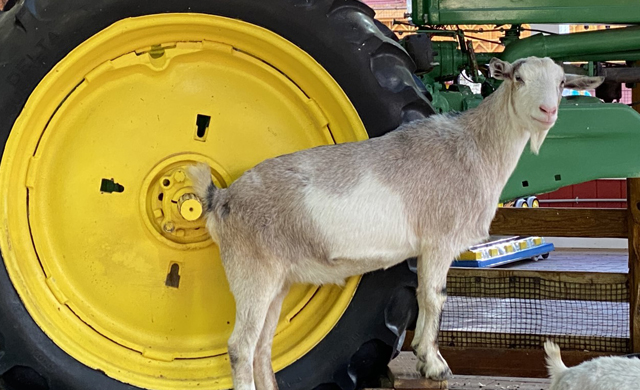
Origin: Southwest Asia & Eastern Europe
Scientific Name: Capra aegagrus hircus
Goats communicate with each other by bleating. Young kids stay close-by their mothers and are identified by their bleat.
They are intelligent, curious animals with an inquisitive nature.
Goats have rectangular pupils. This gives them a vision for 320 to 340 degrees around them without having to move (compared to humans with 160-210)!
They are ruminant animals. Their stomach consists of four different chambers.
Worldwide, more people eat and drink milk from goats than any other animal. In earlier centuries, goats were often used to nurse babies.
Sheep
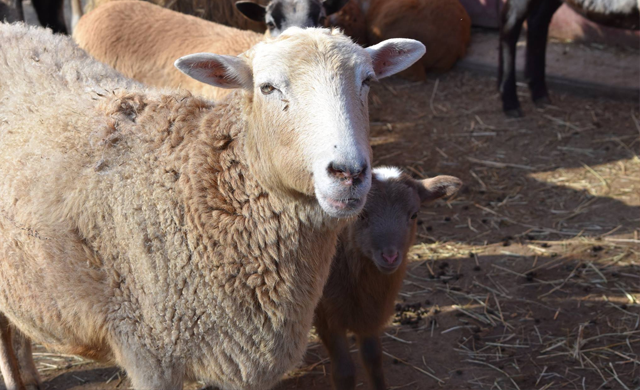
Origin: Europe and Asia
Scientific Name: Ovis aries
Sheep are quadrupedal, ruminant mammals typically kept as livestock. Like most ruminants, sheep are members of the order Artiodactyla, the even-toed ungulates.
Although the name sheep applies to many species in the genus Ovis, in everyday usage it almost always refers to Ovis aries.
Numbering a little over one billion, domestic sheep are also the most numerous species of sheep.
An adult female is referred to as a ewe, an intact male as a ram, occasionally a tup, a castrated male as a wether, and a young sheep is a lamb.
Alpaca
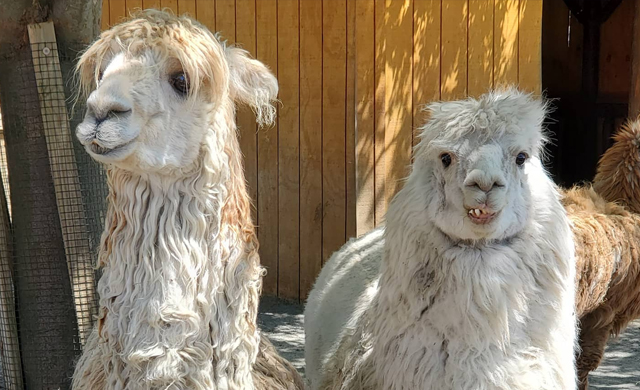
Origin: The Andes
Scientific Name: Vicugna pacos
Alpacas are camelids, domesticated versions of the vicuña.
There are no wild Alpacas. They are domesticated and live on farms or as pets. Mainly raised for their soft wool.
Alpacas communicate with many vocalizations. Humming is the most common!
They can successfully mate with llamas. The crossbreed is called a huarizo.
Alpaca babies are called crias.
Geoffroy’s Marmoset
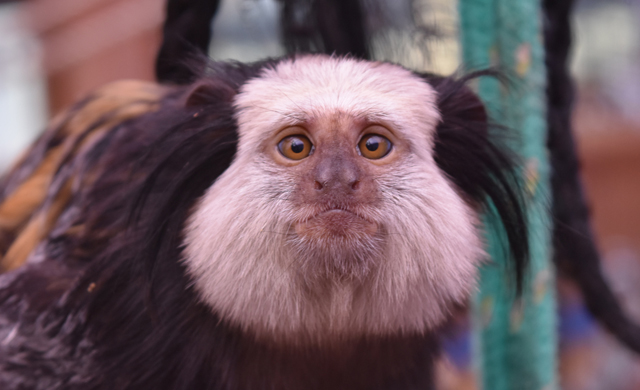
Origin: Brazil
Scientific Name: Callithrix geoffroyi
Geoffroy’s Marmosets are about 8 inches in length with a tail of about 11 inches.
Marmosets are among the only monkeys that regularly give birth to twins.
They are social animals and live in groups called troops led by a dominant female and male.
They are monogamous.
Only the dominant female in the group will give birth.
The entire troop including the males will help raise the offspring.
Squirrel Monkey
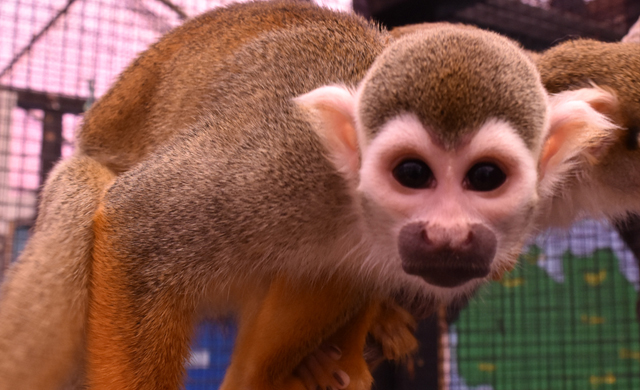
Origin: Central & South America Scientific Name: Saimiri sciureus
A squirrel monkey tail is not prehensile, that means they cannot use it to grab onto things. They use it for balance, nothing more.
Like humans, squirrel monkeys are diurnal. This means they sleep at night and are most active during the day.
Squirrel monkeys are considered to be one of the cleverest monkeys due to having a large brain compared to the size of their body.
They have 25-30 different types of calls for communication.
A squirrel monkey named Miss Baker once traveled into space as part of the US Space program, and returned home safely!
Ring-Tailed Lemur
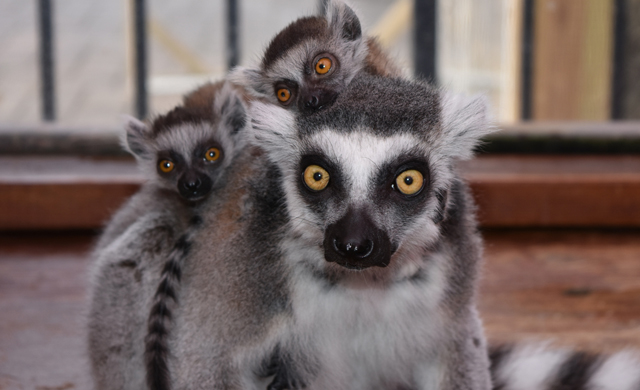
Origin: Southern Madagascar
Scientific Name: Lemur catta
Ring-tailed lemurs are listed as ENDANGERED on the IUCN Red List. Lemurs are the most endangered primate species. Human destruction of their tropical forest habitat in Madagascar is the chief cause.
Lemurs are also being increasingly hunted by humans for food even though hunting lemurs is illegal in Madagascar.
Ring-tailed lemurs are large, vocal primates with a distinctive tail with alternating black and white rings.
Their stomachs aren’t as furry as the rest of their bodies so they often point their stomachs in the direction of the sun for warmth.
Ring-tailed lemurs are a very social animal and live in groups known as troops.
Japanese Koi

Origin: Amur & Red River in Eastern Asia
Scientific Name: Cyprinus rubrofuscus
Koi are the domesticated version of the Amur carp.
They can reach up to 3 feet in length. The size of the fish depends on it’s living conditions.
In Japanese culture, it is the koi symbolizes wealth, prosperity, love, success and good fortune.
Koi can hibernate during the winter. They swim to the bottom of the pond where temperatures are warmer and remain dormant until the weather improves.
Koi usually live 25 to 30 years, but in good conditions, they can live over 100 years!
Read-Eared Slider Turtle
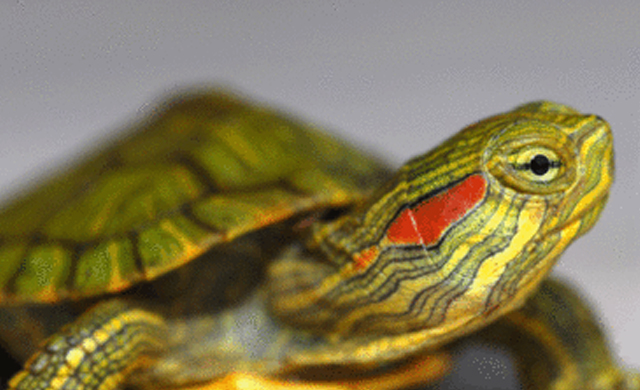
Origin: Southern United States & Northern Mexico
Scientific Name: Trachemys Scripta Elegans
Red-eared Sliders top shell is called a carapace and is brightly marked.
The bottom shell is called the plastron and is yellow with a dark, rounded blotch in each scute (section).
A baby turtle will become a boy or girl depending on the temperature within the nest. Eggs that are incubated at temperatures between 22 and 27 degrees Celsius become only males, while eggs that are incubated at warmer temperatures become females
The red-eared slider is the most popular pet turtle in the United States.
Spurred Tortoise
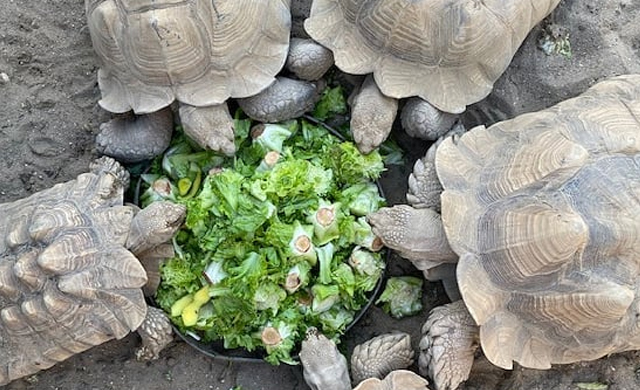
Origin: Edges of the Sahara Desert
Scientific Name: Centrochelys sulcata
The African spurred tortoise is native to the Sahara Desert and the Sahel, a transitional ecoregion of semiarid grasslands, savannas, and thorn shrublands found in the countries of Burkina Faso, Chad, Eritrea, Ethiopia, Mali, Somalia, Mauritania, Nigeria, Senegal, and Sudan
In these arid regions, the tortoise excavates burrows in the ground to get to areas with higher moisture levels, and spends the hottest part of the day in these burrows.
The spurred tortoise is the third-largest species of tortoise in the world after the Galapagos tortoise, and Aldabra giant tortoise, and the largest of the mainland tortoises.
Adults can reach 83 cm (33 in) and can weigh 105 kg (231 lb).
African Grey Parrot
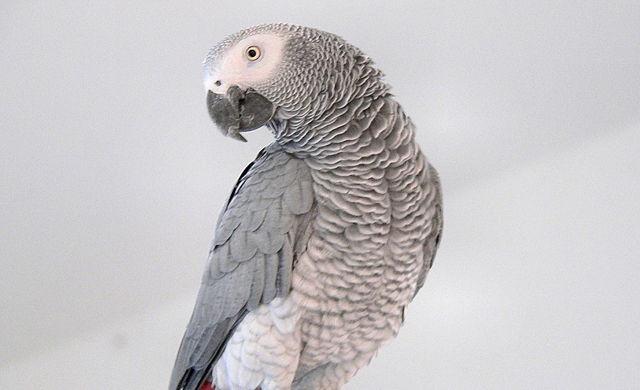
Origin: Equatorial Africa
Scientific Name: Psittacus erithacus
Listed as ENDANGERED on the IUCN Red List. Since 1992 Ghana has lost 90 to 99 percent of its African Grey parrot population due to the pet trade and forest loss, particularly the felling of large trees where the parrots’ breed, are major factors contributing to the decline.
Lives an average of 60 years, some birds reach 80 years old.
Has the same intelligence level as a 4-6-year-old child in some tasks.
Can identify request, refuse, categorize & quantify objects and respond to questions concerning concepts of color and shape.
Pony
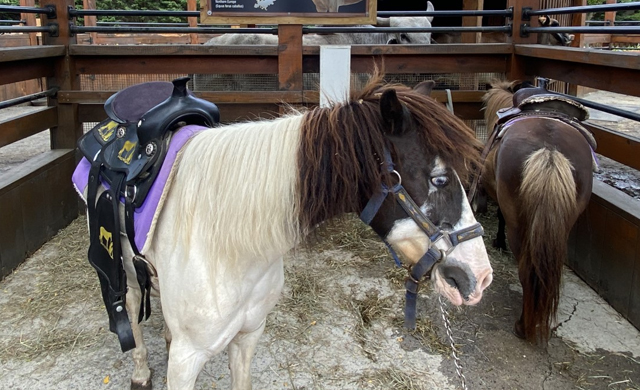
Origin: Northern Europe
Scientific Name: Equus ferus caballus
Ponies have thicker manes and tails than horses. They also have proportionally shorter legs, thicker necks, and shorter heads.
Their temperament also separates them from horses. They are steady and have gentle dispositions as a whole, making them a good choice for children learning to ride.
Pound for pound, ponies are stronger than horses.
The oldest living pony recorded was Teddy E. Bear who lived to 55 years old!
Miniature Horse
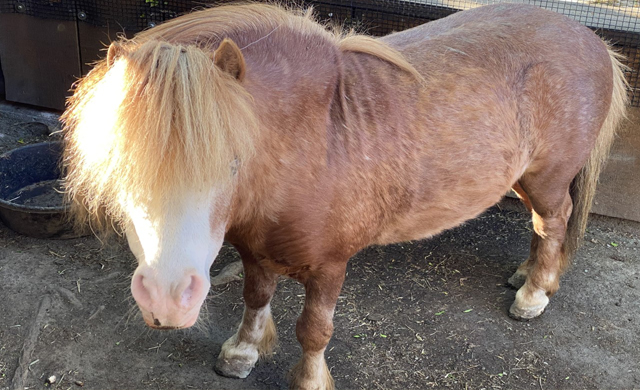
Origin: Europe
Scientific Name: Equus ferus caballus
Miniature horses are horses defined by their small height.
Depending on the particular breed registry involved, the height of these horses is usually less than 34–38 inches as measured at the last hairs of the mane, which are found at the withers.
Miniature horses are generally bred to be friendly and to interact well with people.
They also can be trained as service animals for disabled people.
The smallest known mini horse is Thumbelina, a sorrel brown mare who measures just 17 inches tall!.
Miniature Donkey
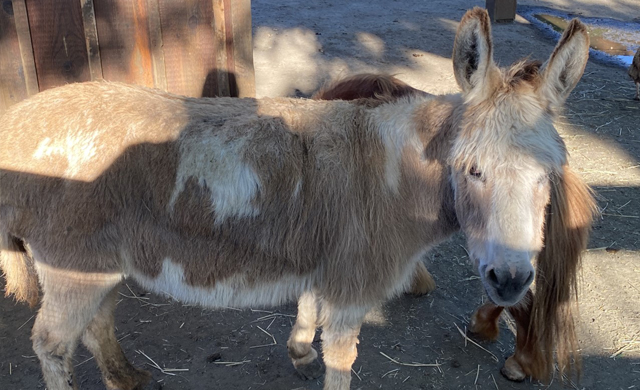
Origin: Sardinia and Sicily
Species: Equus asinus domestic miniature
Donkeys differ from horses in shape and are characterized by their large head, long ears, and cow-like tail.
Their eyes are at the sides of their heads, giving them a wide field of vision. They have both monocular and binocular vision, which allows them to see two fields of vision at once
Donkeys communicate by braying, a sound is also known as a “hee-haw.” Each donkey has its own style of braying, which can range from barely being audible to a “thunderous bray.”
Male donkeys are called jacks and females are jennets or jennies.
Miniature donkeys are very popular as companion animals and for show.